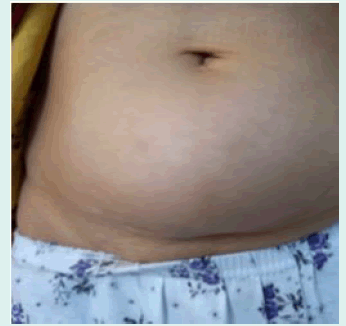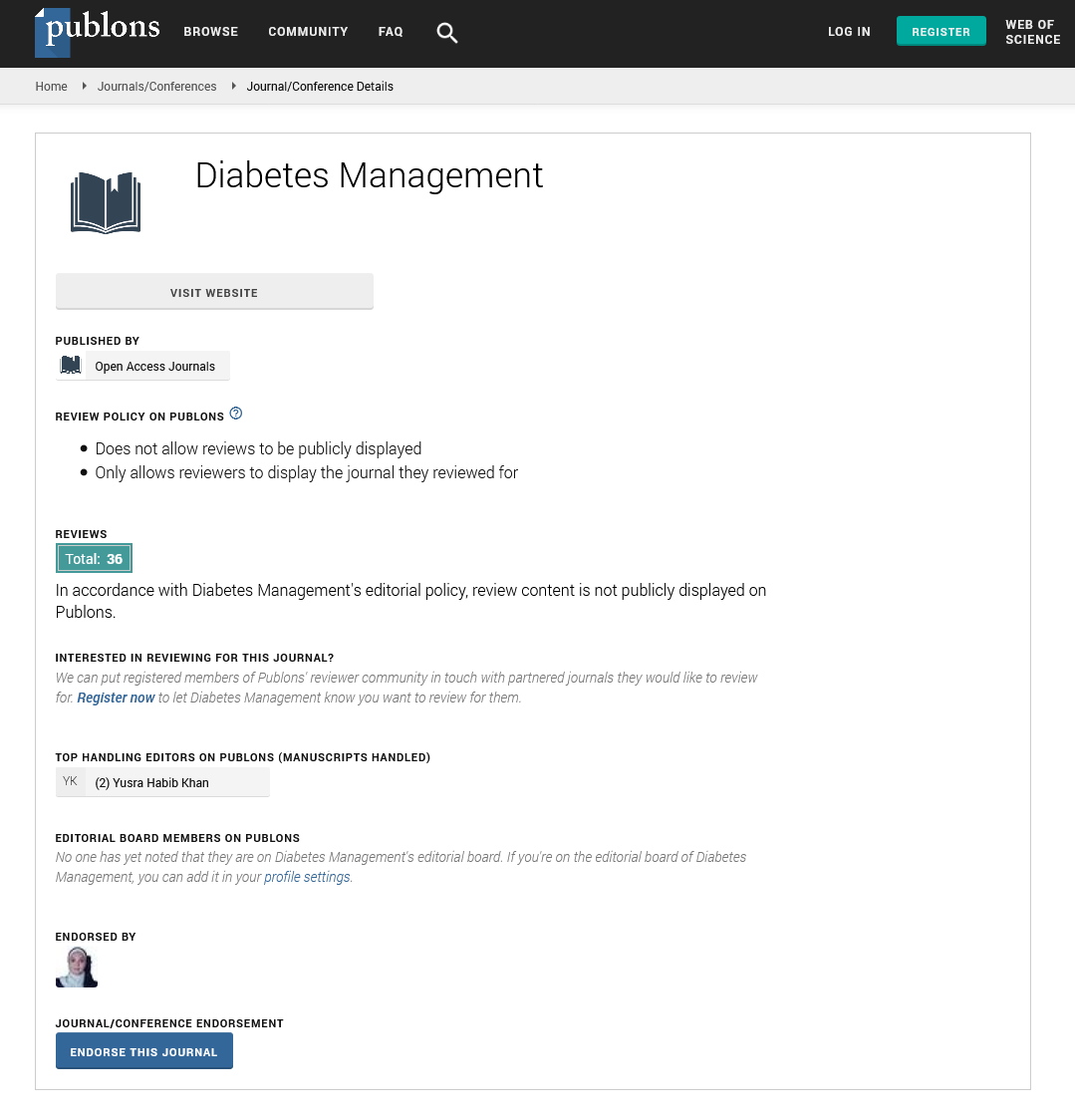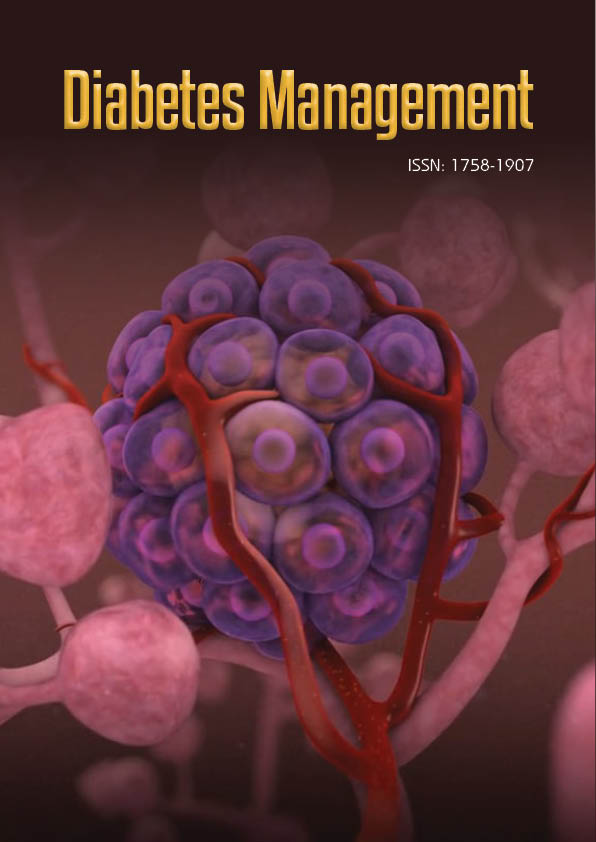Case Report - Diabetes Management (2025) Volume 15, Issue 1
Lipodystrophy with an uncommon clinical presentation in a patient with type 2 diabetes on insulin therapy
Chaima Jemai*, Achwak Mehrez, Yosra Htira, Takwa Moussa, Zohra Hadj Ali, Salma Mohsen, Olfa lajili, Hana Ben Jemaa, Imen Hedfi, Faika Ben Mami
Department of Diabetology, University of Sfax, Sfax, Tunisia
- *Corresponding Author:
- Chaima Jemai
Department of Diabetology, University of Sfax, Sfax, Tunisia
E-mail: jemaichaima87@yahoo.fr
Received: 20-Mar-2024, Manuscript No. FMDM-24-130102; Editor assigned: 22- Mar-2024, PreQC No. FMDM-24-130102 (PQ); Reviewed: 05-Apr-2024, QC No. FMDM-24-130102;Revised: 15-Jan-2025, Manuscript No. FMDM-24-130102 (R); Published: 22-Jan-2025, DOI: 10.37532/1758-1907.2025.15(1).657-660.
Abstract
Introduction: We report the case of a patient with type 2 diabetes on insulin therapy who had a lipodystrophy with uncommon clinical presentation.
Case presentation: This was the case of a 67-years-old female with type 2 diabetes hospitalized for exploration and management of severe and recurrent hypoglycemia. Her diabetes was evolving since the age of 40 years and was complicated by a minimal retinopathy. She was on premixed human insulin, administered through insulin syringe for the last 17 years. She presented a history of well-controlled diabetes until 5 months back when she started to present a fluctuating blood glucose concentration, with episodes of unpredictable hypoglycemia occurring in variable times, with values inferior to 0.3 g/l associated to neurological features. Clinical examination revealed a swelling localized in the hypogastric region of the abdomen. It was painless, firm, not fixed to the underlying plans, without local inflammatory signs and had appeared in the patient’s preferred insulin injection site. Thus we retained the diagnosis of insulin induced lipohypertrophy. The patient has reported reusing needles up to one week for economic reasons and not frequently rotating insulin injections’ sites. The patient finds less painful injection in lipohypertrophic area and she continued to inject insulin into that zone leading to its progressive enlargement. The therapeutic management consisted in switching the patient to insulin analogues and the resumption of the education concerning the correct injection techniques.
Conclusion: Insulin injection technique continues to be suboptimal in many insulin treated patients and our case emphasizes the need for improved awareness and education.
Introduction
Lipodystrophy is a common complication of subcutaneous insulin injection in patients with diabetes. It may affect insulin absorption resulting in a negative impact on glycemic control. We report the case of a patient with type 2 diabetes on insulintherapy who had a lipodystrophy with uncommon clinical presentation.
Case Presentation
A 67-years-old female with type 2 diabetes female hospitalized for exploration and management of severe and recurrent hypoglycemia. She had a medical history of hypertension and dyslipidemia. Her diabetes was evolving since the age of 40 years and is complicated by a minimal retinopathy. She was on premixed human insulin, administered through insulin syringe, for the last 17 years.
She presented a history of well-controlled diabetes until 5 months back when she started to present a fluctuating blood glucose concentration, with episodes of unpredictable hypoglycemia occurring in variable times, with values inferior to 0.3 g/l associated to neurological features (agitation and aphasia). She reported no other symptoms. Her weight status was normal attested by a BMI of 20 kg/m. There was no story of involuntary weight loss.
Clinical examination revealed a swelling localized in the hypogastric hypogastric region of the abdomen (Figure 1). It was painless, firm, not fixed to the underlying plans, without local inflammatory signs and had appeared in the patient’s preferred insulin injection site. Thus we retained the diagnosis of insulin induced lipohypertrophy.
FIGURE 1: Clinical examination revealed a swelling localized in the hypogastric hypogastric region of the abdomen.
On reviewing the injection techniques: The patient has reported reusing needles up to one week for economic reasons and not frequently rotating insulin injections’ sites. The patient finds less painful injection in lipohypertrophic area and she continued to inject insulin into that zone leading to its progressive enlargement.
Biological test revealed an HbA1c of 8.7%, normal renal, hepatic and thyroid biological parameters and normal basal cortisolemia.
The therapeutic management consisted in switching the patient to insulin analogues and the resumption of the education concerning the correct injection techniques; she was advised not to inject insulin into the lesion anymore, to rotate injection sites and to minimize reuse of needles.
Surgical resection of the lipodystrophy, for aesthetic purposes, was proposed but refused by the patient.
Discussion
Lipodystrophy is a common adverse effect of insulin subcutaneous injections with a prevalence estimated at 41.8% according to a recent metaanalysis [1]. It is related to changes in the subcutaneous fatty tissue and could be hyper or hypotrophic and involves immunological mechanisms as well as the lipotrophic effect of insulin [2]. Injection into lipodystrophied sites, results in an abnormal absorption of insulin, leading to glycaemic variability and a negative impact on diabetes control [2].
Lipodystrophy, is more reported in young type 1 diabetics and rarely occurs in type 2 diabetic [3-5]. The injection technique, repetitive needles use, for economic or personal convenience, number of daily injections, not rotating injection sites, depth of insulin application and injection area size and long duration of insulin therapy are the most incriminated factors to be associated to developing of lipodystrophies [6-8].
Likewise, several clinical features such as younger age, lower BMI and higher daily insulin dose, have been demonstrated as factors associated to increased lipodystrophy risk in other studies. In addition to their anesthetic character, lipodystrohies could be a factor of unbalanced diabetes, due to alteration of insulin absorption patterns [3,8]. In a recent study, an association between lipodystrophy and glycemic variability was demonstrated by using the continuous glucose monitoring.
Our case constitute an extreme case with bulky lipodystrophy developing in an unusual location and resulting an erratic glycemic variability and severe unpredictable hypoglycemia. In similar cases, both vital and esthetic prognosis are engaged and liposuction may be required to manage this complication. These evidence emphasizes that both, patients and caregivers, should be aware of this complication, its favorable factors and its consequences, especially glycemic variability. Regular examination of injection sites is recommended in all insulin treated patients.
Inspection and palpation should be associated for optimal screening of these lesions. Prevention consists mainly in educating patients concerning the proper injections techniques, the importance of rotating injection sites and regular changing of insulin needles.
Conclusion
Lipodystrophies are a common complication of insulin injection. They are not aesthetic, are cause of unexplained hypoglycemia and are associated with uncontrolled diabetes.
Insulin injection technique continues to be suboptimal in many insulin-treated patients and our case emphasizes the need for improved awareness and education.
References
- Wang K, Zhang S, Liu C, et al. âA meta-analysis and meta-regression on the prevalence of lipohypertrophy in diabetic patients on insulin therapy.â Therapies. 76, 617-628 (2021).
[Crossref] [Google Scholar] [PubMed]
- Heinemann L. âInsulin absorption from lipodystrophic areas: A (neglected) source of trouble for insulin therapy?.â J Diabetes Sci Technol. 4, 750-753 (2010).
[Crossref] [Google Scholar] [PubMed]
- Deeb A, Abdelrahman L, Tomy M, et al. âImpact of insulin injection and infusion routines on lipohypertrophy and glycemic control in children and adults with diabetes.â Diabetes Therapy. 10, 259-267 (2019).
[Crossref] [Google Scholar] [PubMed]
- Omar MA, El-Kafoury AA, El-Araby RI. âLipohypertrophy in children and adolescents with type 1 diabetes and the associated factors.â BMC. 4, 1-3 (2011).
[Crossref] [Google Scholar] [PubMed]
- Tsadik AG, Atey TM, Nedi T, et al. âEffect of insulinâinduced lipodystrophy on glycemic control among children and adolescents with diabetes in Tikur Anbessa specialized hospital, Addis Ababa, Ethiopia.â J Diabetes Res. 2018, 4910962 (2018).
[Crossref] [Google Scholar] [PubMed]
- Baruah MP, Kalra S, Bose S, et al. An audit of insulin usage and insulin injection practices in a large Indian cohort. Indian J Endocrinol Metab. 21, 443-452 (2017).
[Crossref] [Google Scholar] [PubMed]
- Pozzuoli GM, Laudato M, Barone M, et al. Errors in insulin treatment management and risk of lipohypertrophy. Acta Diabetol. 55, 67-73 (2018).
[Crossref] [Google Scholar] [PubMed]
- Blanco M, Hernandez MT, Strauss KW, et al. Prevalence and risk factors of lipohypertrophy in insulin-injecting patients with diabetes. Diabetes Metab J. 39, 445-453 (2013).
[Crossref] [Google Scholar] [PubMed]


